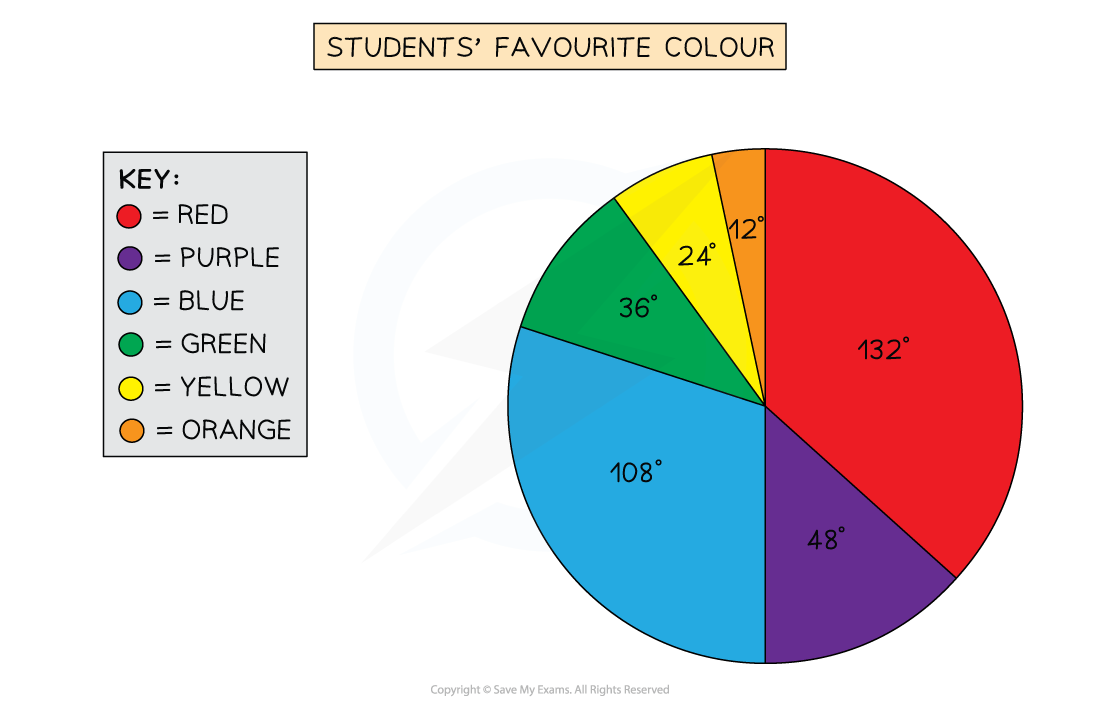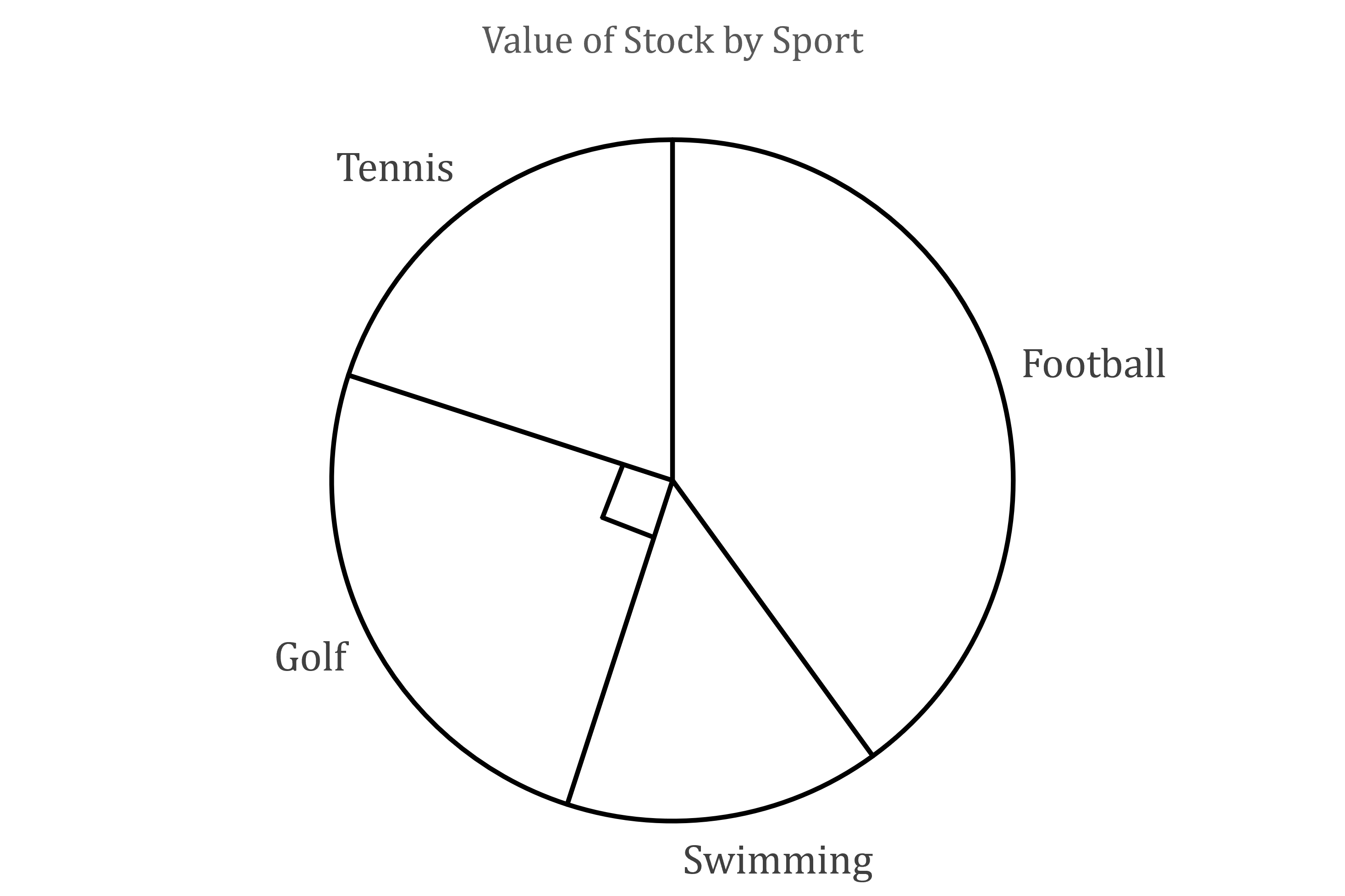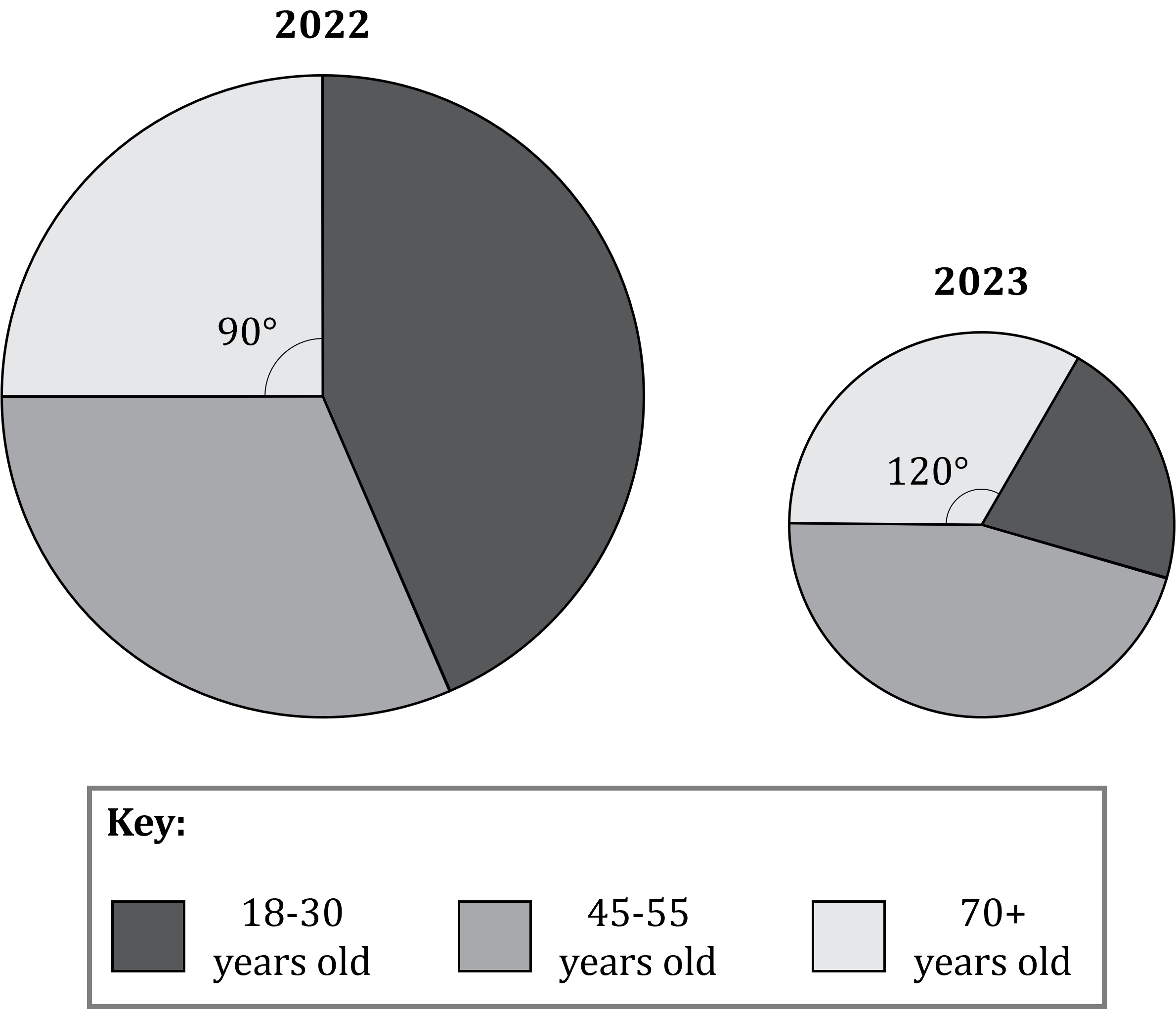Pie Charts (Edexcel GCSE Statistics) : Revision Note
Pie Charts
What is a pie chart?
A pie chart is a circle which is divided into slices (sectors) to show proportions
They show the relative size of categories of data compared to each other
rather than their actual size or number
e.g. looking at the proportions of men and women working for a company, we might be more interested in the relative sizes of the groups than in the actual numbers of men and women
There are 360° in a circle
We can use this to help us calculate the size of each slice of the pie chart
How do I draw a pie chart?
This is shown easiest through an example
The following data is collected for a class of 30 students about their favourite colour
Colour | Red | Purple | Blue | Green | Yellow | Orange |
Students | 11 | 4 | 9 | 3 | 2 | 1 |
STEP 1
Find the number of degrees that represents 1 studentThere are 30 students in total, so 360° = 30 students
Divide both sides by 30, so 12° = 1 student
STEP 2
Calculate the angle for each category by finding a fraction of 360°11 students out of 30 said red was their favourite colour,
so this is
4 students out of 30 said purple,
so this is
Repeat this for each category, they should sum to 360° in total
Colour | Red | Purple | Blue | Green | Yellow | Orange |
Students | 11 | 4 | 9 | 3 | 2 | 1 |
Angle | 132° | 48° | 108° | 36° | 24° | 12° |
STEP 3
Draw the pie chart, using a protractor to measure the anglesStart by drawing a vertical line from the centre of the circle to the top ("12 o'clock")
Then use your protractor to measure the first angle and draw a line to this point
Move your protractor to this line, and repeat for the next category
Continue until the slices for all the categories are drawn
You should include a key or labels to show which slice represents which category



How do I interpret a pie chart or find missing information?
It is easy to spot from a pie chart which category is the largest or smallest proportion
But you may be asked to do something more advanced like finding some missing information
Remember that all of the data is represented by 360°
You can use the information you are given to find
how many degrees each person/piece of data is represented by
how many people/pieces of data 1 degree represents
For example if you are told that there is a slice measuring 30° which represents 15 people
30° = 15 people
1° = 0.5 people (divide by 30)
2° = 1 person (divide the first statement by 15, or double the second statement)
You can then use this information to help solve problems or find missing information
Examiner Tips and Tricks
A pie chart given in an exam may not be to scale
If it is not to scale, do not try to use your protractor to measure it!
Instead use the methods described in this revision note to calculate the information you need
Worked Example
The following pie chart is created to show the total value of items stocked in a sports shop for 4 different sports.

(a) Using the angle marked on the pie chart, and the fact that the shop stocks $12 000 worth of Golf items, find the total value of the shop’s stock across the 4 sports.
The angle marked on the diagram is 90°
So a quarter of the stock is for golf
That means we can multiply the value of the golf stock by 4 to find the total value of the shop’s stock
Total value is $48 000
(b) Given that the angle on the pie chart for Tennis is 72°, find the value of the Tennis items that the shop stocks.
The fraction of the value of the shop’s stock will be the same as the fraction of the circle for each category
Therefore the value of tennis items will be
Value of tennis items is $9 600
Comparative Pie Charts
How are comparative pie charts different from regular pie charts?
For two data sets of different sizes (different total frequencies), drawing two pie charts that are the same size can be misleading
It makes it 'look like' the two sets are the same size
A sector ('slice') in one pie chart can be the same size as a sector in the other one
even though the number of things represented can be very different
With comparative pie charts, the areas of the two pie charts are in the same ratio as the total frequencies of the two data sets
e.g. if one pie chart represents data for 500 people and the other one represents data for 1000 people
then the area of the second chart will be twice as big as the area of the first one
because
The relationship between the radiuses of two pie charts and the total frequencies of their data sets can be given by the formula
is the radius of the pie chart for data set 1
is the total frequency of data set 1
is the radius of the pie chart for data set 2
is the total frequency of data set 2
It can be rearranged as
This can be used to find
if you know the other three values
Or as
This can be used to find
if you know the other three values
The formula is not in the formula booklet so you need to remember it
It might help if you understand where it comes from
Remember that the area of a circle is
So we want the areas to give
That's the same as
Cancel the
's to get
To get the '
' version
multiply both sides by
to get
then take square roots:
To get the '
' version
multiply both sides by
to get
How do I compare two data sets represented by comparative pie charts?
When comparing two data sets represented by comparative pie charts:
To compare frequencies compare areas
This is true for the total frequencies
It is also true for the frequencies of individual sectors
To compare proportions compare the angles of the sectors
If a question asks you about frequencies of individual sectors
it is may be easier to find the total frequencies of the pie charts first
See the Worked Example
Examiner Tips and Tricks
If the question tells you that comparative pie charts are "drawn accurately", then you can find
their radiuses by measuring with your ruler
the angles of sectors by measuring with your protractor
Worked Example
In 2022, a cruise line started offering combined '18-30, 45-55 and 70+' cruises.
The comparative pie charts show information about the numbers of people from each age group that went on these cruises in 2022 and in 2023.

The radius of the pie chart for 2023 is smaller than the radius of the pie chart for 2022.
(a) Explain what can be deduced from this information.
A smaller radius means a smaller area
And with comparative pie charts a smaller area means a smaller total frequency
Fewer people went on the cruises in 2023
1250 people who were 70+ years old went on the cruises in 2022.
The radius of the 2022 pie chart is 5 cm, and the radius of the 2023 pie chart is 3 cm.
(b) Work out the number of people who were 70+ years old that went on the cruises in 2023.
Work out the total number of people who went on cruises in 2022 of the 2022 circle is taken up by the '70+' sector
That corresponds to 1250 people, so
Divide both sides by
Use to find the total number of people for 2023
,
and
will then be the total frequency for 2023
Multiply both sides by 5000
Now work out the number of people 70+ years old who went on cruises in 2023 of the 2023 circle is taken up by the '70+' sector, so
600 people who were 70+ years old went on the cruises in 2023

You've read 0 of your 5 free revision notes this week
Sign up now. It’s free!
Did this page help you?

